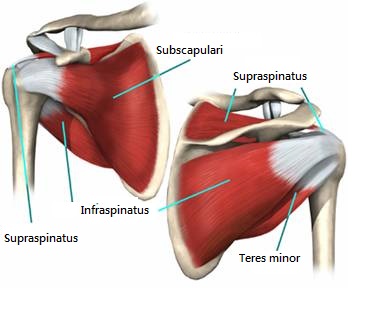Frozen shoulder
This post is also available in: 中文
Onset of frozen shoulder
Mrs. Wong is a 40-year-old housewife. Half a year ago, she noticed pain in the left shoulder when waking up, and she had problem elevating the left arm. Pain is tolerable when shoulder elevation is avoided. Therefore Mrs. Wong did not take it seriously. However, the left shoulder gradually became stiff and the range of motion became more and more limited. It was not until half a year later did Mrs. Wong attend doctor. A referral for physiotherapy was made.
The structure of the shoulder joint
The shoulder joint is the most mobile joint in human body. Directly outside of the joint is a joint capsule. The shoulder is stabilized by a group of four muscles, called the rotator cuff.

The development of a frozen shoulder
Patients with frozen shoulder are usually around 40-50 years old, though the condition may also develop in people as young as 30 years old.
The cause of frozen shoulder is unknown. Adhesion develops within the capsule of the joint, leading to a decrease in range of movement. In early stage, pain will be the most prominent symptom, which may affect sleep quality. Months after onset, the pain may gradually decrease and replaced by severe stiffness. Patient may have difficulty wearing clothes or washing hair. In the end the stiffness may gradually resolve. The whole process may take more than one year if left untreated.
Physiotherapy for frozen shoulder
Physiotherapy can relieve pain and increase the range of movement. However serious conditions will take longer to recover.
The therapist will apply different treatment according to the individual condition of each patient. General treatments include:
Manual therapy
Manual therapy is used to relieve the tension in soft tissues, mobilize the stiff joints and increase blood circulation in the affected regions.
Electrotherapy
Different kinds of electrotherapy, such as ultrasound, transcutaneous electrical nerve stimulation (TENS), interferential therapy (IFT), may be applied for pain relief and improving circulation.
Exercise therapy
For patients with frozen shoulder, appropriate exercise is very important to maintain the effect of treatment.
The condition of Mrs. Wong was relatively serious. Her shoulder joint was already very stiff when she attended physiotherapy. Range of movement was very limited. It took three months for Mrs. Wong’s shoulder to return to normal range of motion. Mrs. Wong needs to keep doing exercise to strengthen the shoulder muscles and maintain range of motion.



